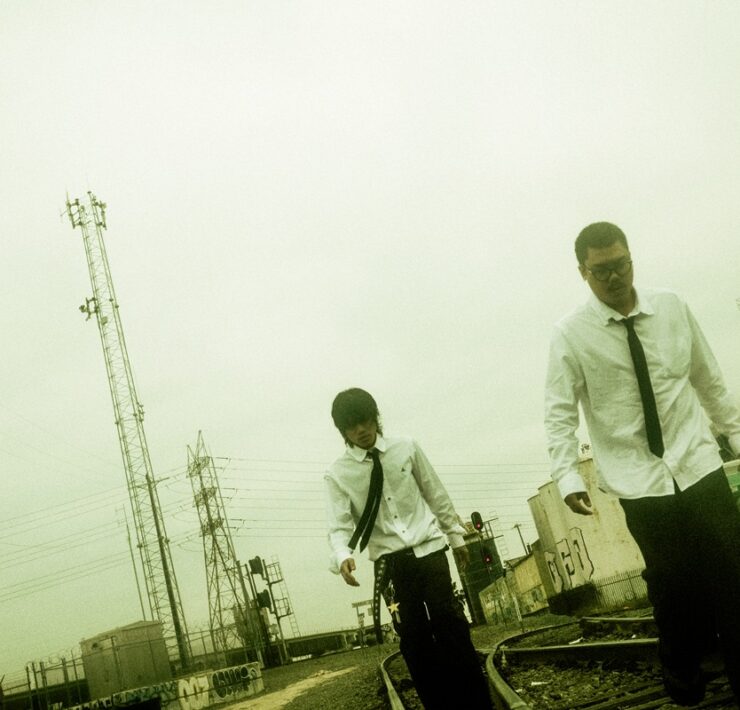Daisy The Great Chats About ‘The Rubber Teeth Talk’

Daisy The Great’s highly anticipated album, The Rubber Teeth Talk, is their finest record to date. The band, consisting of Kelley Dugan, Mina Walker, Nardo Ochoa, and Matti Dunietz, rose to prominence with their debut single, “The Record Player Song,” which went viral on TikTok. The song eventually was remixed with AJR, again becoming a trending song on TikTok. Their newest album, The Rubber Teeth Talk, is hypnotically catchy and quirky with stunning vocal harmonies, entrancing instrumentation, and pensive storytelling. The Rubber Teeth Talk is one of the best indie pop/rock records of the year.
Dugan and Walker chat with OFM about The Rubber Teeth Talk.
Creating the Songs
“It just felt good to be like writing the songs, sit with them for a little bit, and let them evolve,” Walker says about The Rubber Teeth Talk. “We had big ideas for them, and I think through having time, we were able to see those big ideas through and keep the beauty and rawness of the song. When you’re making music for over two years, it’s interesting how your taste in music is always changing and evolving. It was really special because I feel like sometimes, if you make something right away, immediately, it’s exactly what you’re thinking about. All the songs draw from different moments in time.”
“It was so hands-on the whole time, which I really appreciate because we’re really invested in the music and really loved being part of every detail that goes into it,” states Dugan.
What the Title of the Record Means
The Rubber Teeth Talk is an intriguing title. So, what does it mean exactly? “It means the dream you or dream voice in your head,” comments Dugan. “It’s the you that’s talking to you when you’re not talking. I think for me, it can be imposter syndrome or, like, doubt voice, but it can also be something that feels really brave and just feels like the inner version of you that’s more private.”
“It’s artificial pressures and this feeling that there’s this moral compass that’s developed for people that’s based in artifice and insecurities,” says Walker. “The Rubber Teeth Talk means there’s a big cloud of information that’s always coming at you, and now, with algorithms built for you and a lot of times against you. It’s just this big mantra that they’re just talking, and it’s not the truth. It’s an artificial thing that is trying to build a world around you. But it can be turned into a positive thing like Kelley is talking about, too.”
Working with Catherine Marks
The Rubber Teeth Talk sees Daisy The Great working with producer Catherine Marks. Marks was one of Daisy The Great’s dream producers to work with. “It leads to a very unique and personal record when a producer has the talent to bring out the best in the artist they’re working with and make suggestions and rein it all in, but they see your vision,” comments Walker. “The thing that made me want to work with her the most was we had one meeting with her on Zoom, and we were on the same page. She listened to some of our music and the demos we had made, and the way she talked about the music was the way we talked about the music. It was like, ‘You really care about it.’ That’s what I mostly wanted: somebody who cared a lot about the songs and saw the songs for what they were.”
“When we called her, I totally knew that she was the one because she really just said things that felt like we would say them, and she was immediately mirroring what we felt the record wanted,” adds Dugan. “She just feels like one of us—Catherine is such a role model and an amazing person to work with.”
How Daisy The Great Evolved with The Rubber Teeth Talk
Daisy The Great wanted The Rubber Teeth Talk to feel very human. Additionally, they felt that with this record, they were more confident than with their previous ones. “Our last record, I think, felt like our first time being professional about it,” explains Dugan. “We put a lot of effort into making it sound exactly like every second of what we imagined. This record, I feel, has a lot of that professionalism in it, but we also really wanted to capture the human in the record and the people that were making the record and allow for that special thing and rawness to be really prevalent. That makes the record feel really special. I can hear us in the studio, in Matti’s basement, and in our rooms writing when I listen to the songs. I think it’s really special. That’s part of what Catherine really brought to the record as well. She really saw us and saw what makes us unique and wanted to capture those moments.”
“Coming from a very DIY background and going into the studio for the first time, I think we were more like, ‘Is this the right way to make this kind of song?’ and more second guessing ourselves,” comments Walker. “This one was like, ‘This is the song we made, and this is how it sounds because we’re making it right now.’ We were more inspired to add things because we were inspired, not because it was missing something.”
Dreams
Dreams play an important role in The Rubber Teeth Talk. Often times songs blend dreams with reality. “Dreams give you metaphor without being too on the nose,” comments Walker. “They’re like these little gifts for you.”
“Thinking about dreams while writing opened the door for what we could think about,” says Dugan. “It allows you to reframe things in your real life with renewed creativity and a new lens that feels like more things are possible. Also, it just allowed us to explore freaky thoughts and have a lot of places that we could go. Maybe the seed of a song was something that was more grounded with something in our real life that we’re trying to work through, but the involvement of dreams helps let that feeling have potential in a lot of different ways.”
One of the best examples of this is “Dream Song.” Daisy The Great wanted to create a song that felt like a dream. “That song, like, as disjointed that it is, I think that we built a flow with it because that really did come with us being ‘Let’s make a song that’s a dream,’ and we just kept making each other laugh while writing the whole thing,” smiles Walker. “We just wanted to capture that atmosphere and feeling of after you’re in a dream. After you tell someone about the dream, it’s, like, really funny, but you don’t realize it’s funny while you’re in it.”
“Part of it was, we were talking about all these different worlds that would exist in this song, and so we had a bunch of different pieces of things that didn’t really have homes yet.” reflects Dugan. “A lot of the time, things like that almost start off as a joke, and then you’re like, ‘This joke is the best version of this,’ and, like, the thing that I can hang on to the most. So, we kept building that and then adding different layers.”
Heartbreak, Loss, and Bad Days
The warmly comforting and melancholically somber “Mary’s At The Carnival” touches on heartbreak. “Everyone was kind of in a weird space, and I was talking to Nardo, and he was saying he was really feeling heartbroken that day,” recalls Walker. “He was going through some changes and heartbreak, and I think we were all going through our own stuff, too. Me and Kelley were singing from a place of heartbreak, and Nardo was singing, like, ‘Mary’s at the carnival/And she’s in love when she hears the music.’ I was like, ‘That’s so sweet what he’s singing,’ but it was tainted with this sadness. I think he was using it to soothe himself of feeling heartbreak. That was really interesting because I think me and Kelley could sense that from him and were singing these more sad lyrics. Then, he brought it together with his singing. I think that’s not typical of, like, heartbreak songs to have a more positive chorus. That was a really nice way to write from a place of heartbreak to write a soothing song for that.”
“Bird Bones” deals with the loss of a close friend. Writing the song was a very therapeutic experience for Walker. “The beginning of that song I wrote, I think, right after she passed,” shares Walker. “I was just freaking out, so I just, like, sat on the floor with my guitar. It’s kind of a creepy voice memo because I’m just barely singing—I just had that voice memo where I was letting something out.”
Walker stopped working on it for a while. After going on a walk, Walker was reminded of her. “I went on a walk, and I was thinking about her on the walk,” she reflects. “I saw this whole entire bird of bones on the ground, over by the bridge. It really reminded me of her because she was super into taxidermy, lizards, and a lot of animal stuff. So it super reminded me of her. I was thinking about how the bird was no longer with us, but I could still see him. I think that was just the missing piece for me in being able to write about her. I feel like I have a lot of tragedy and death in my life that I think it’s so hard to write about without being so explicit and wanting to be so poetic and let it out, but also making it more than something than just grief. I think that that was a good reference point for me, like this metaphor was given to me by the world around me, and then I was like, ‘I wanna make the song feel cathartic.’”
In the sweet and heartwarming “Dog,” Daisy The Great name-drops the beloved bear Winnie the Pooh. “I was just like on my phone and in a horrible mood, and I was walking around, and I saw on the curb there was a Winnie The Pooh stuffed animal with his head face down in this gross puddle, and I just felt very connected to him at that moment,” says Dugan. “I was like, ‘I’m you, and you are me.’ So, I sat by him. It just brought a sense of levity. It felt like a little kiss on the head from the world that was like, ‘Your day is bad, but you are him.’”
Turning a Funny and Freaky Trip to the Dentist Into a Groovy Song
“Swinging” was inspired by a funny but very freaky experience Dugan had at the dentist. “I went to the dentist, and they gave me laughing gas, and then I fell into this hole in my brain, like this huge black hole, and I was, like, aware that I was at the dentist, but I couldn’t do anything,” she laughs. “I was in this big world, and I was like, ‘I don’t know how to get out.’ Then I heard the dentist say, ‘OK. Open your mouth.’ I was like, ‘I don’t have control of my mouth. I’m inside this huge hole in my head. I can’t do anything.’ It was really scary—It just needed to be as freaky as it was.”
“We wanted to have a pretty dorky but also groovy bass line because we thought it was such a funny story,” grins Walker. “We were like, ‘Let’s emphasize the funniness.’ We definitely went super clown at first. Then we pushed it into a bit cooler and fuzzier direction.”
Additionally, “Swinging” draws inspiration from multiple artists and genres. “I always wanted to have a chorus with this, like, high little frog singing to you and thought about the song ‘Genius Of Love’ by Tom Tom Club,” comments Walker. “When we were demoing the song, I just saw the Talking Heads live show documentary. I really was inspired by their performance and funky vibe. It was funky but still felt rocky to me. That tactile, funky sound was fun for me. I definitely drew from that. Also, I feel like we drew from 2000s noisy pop like Superorganism and Sleigh Bells, building a fuzzy candy sound throughout.”
Capturing the Live Sound, Creating a Pop Opera, and Building a Huge Feeling
For “Ballerina,” Daisy The Great really wanted a song that captured how they sounded live. “‘Ballerina’ is a very good representation of how we perform live and sound live,” remarks Walker. “When we were first performing it, we played it extremely fast. We played it for Catherine, and she was like, ‘I don’t really like that one.’ Then she was like, ‘Wait, slow it down.’ We chilled it out a little bit but still kept the high energy—We played it literally like three times faster than that, which is like a frenetic energy. When we slowed it down, she was like, ‘This is the best song on the record.’ I think it was fun to play it that fast and then ground it and root it and put all these extra elements in ‘cause she was like the words are important, and I want people to know that it’s more than just a derivative punk garage song.”
“Lady Exhausted” feels like a ‘pop opera,’ with many fascinating sections throughout. “I was just starting to play with more production,” reflects Walker. “It had so many evolutions. I made it and was like, ‘This is a crazy song, and I have no idea what to do with it. Maybe it could be a Daisy song.’ When me and Kelley were writing again, I brought that song out and was like, ‘I like the lyrics of this song a lot, but I don’t really like the chords.’ The chords just didn’t feel right. They didn’t feel like they were holding up the song the way I wanted to. Then we made a new version of it with more dissonant chords … We just made it this song where we could do whatever we want.”
“The verses feel really tight and chugging, and that allowed for there to be spaces that felt more lush and sweeping,” says Dugan. “Like now we’re gonna make a really Queen vibes, stacked opera moment, and then we’re gonna let that go away and do the next thing. Build it in a way that feels really creative and serves that moment of the song.”
The Rubber Teeth Talk ends with “Sue Me, Alice,” which features an exhilarating outro. “There’s something missing from the record that’s like giving everything you have,” says Dugan. “Vocally, it felt so good to build something that was a really huge feeling—It unlocked another part of something we hadn’t fully done yet on the record. With it being the end, it allowed us to have this timeless space at the end of the song.”
Concluding Comments
The Rubber Teeth Talk drops on June 27. If you want an indie pop/rock record that you can blast all summer long, be sure to check it out.
Follow Daisy The Great on Facebook, Instagram, and X (Twitter). to keep up-to-date with the latest announcements.
Photo courtesy of Daisy the Great










